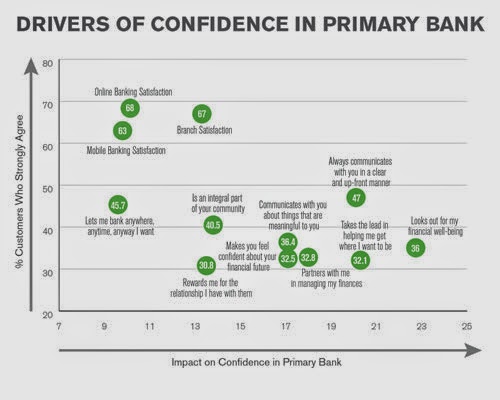This post is part of Gallup's ongoing series on the shifting landscape for financial institutions. It provides insights into channel optimization, emerging customer behaviors and preferences, product penetration and relationship growth, engaging the most critical affluent and business customers, and reshaping banks' overall value proposition.
To anyone who regularly reads the news (or watches "The Daily Show"), it will come as no surprise that Americans' confidence in banks as an institution is low. Stories of banks' ineptitude may not be coming out as frequently as they were during the days of TARP, bank failures, bank saving mergers, excessive personal spending by executives, and debit card fee debacles, but the banking industry in general has not done enough to restore its reputation as a whole. Spend 10 minutes perusing any of the more than 23 million links that come up when you Google "banks suck" and it quickly becomes apparent just how much residual ill will there is among the general public toward the banking industry.
That said, as anyone who reads the banking trade press knows, several industry surveys (including our own) have found that customers' loyalty, engagement, and satisfaction with their own banks has been increasing. And this trend does translate into people having more confidence in their primary bank than in the industry in general.
So what can banks do to change their customers' perceptions? Using data collected during Gallup's latest Retail Banking study, we have identified four areas of opportunity for banks to increase customer confidence.
1. When it comes to confidence, channel service is table stakes.
How you serve your customers is hugely important. If they are not having a consistently exceptional experience every time and every place they interact with you, you are not even in the game. Unsurprisingly, the people-based channel -- the branch -- is better at driving confidence than technology-based channels. As we see time and again when we study channels, lack of satisfaction in technology-based channels is more likely to drive a negative outcome than satisfaction is to drive a positive outcome. Just as positive experiences with bank employees in the branch are more likely to drive customer engagement, those experiences are also more likely to inspire confidence. People still like people and trust people more than technology, even if customers are increasingly interacting with technology.
2. Traditional marketing messages are fine, but are not resonating.
- "Lets me bank anywhere, anytime, anyway I want"
- "Is an integral part of your community"
- "Rewards me for the relationship I have with them"
Variations on these themes are often integral parts of banks' marketing messages and brand promises. And while they do positively impact the confidence people have in their bank, the majority of customers don't agree that their bank is delivering on these promises. The highest scoring attribute in this group is "lets me bank anywhere, anytime, anyway I want," which makes sense in the context of most banks trying to improve the multichannel experience. Yet even that driver only managed a score of 46%. "Rewards me for the relationship I have with them" is the lowest scoring attribute at 31%. While many banks are trying various things to reward customers for their business (particularly in the mass affluent space), most don't deliver on this in a large way across a large swath of customers.
3. Communication is key.
As we move into the areas that have the strongest impact on confidence in a customer's primary bank, the importance of communication becomes clear. Customers are more likely to agree that their banks always communicate with them in a clear and upfront manner than they are to agree that banks communicate with them about things that are meaningful. There is still room for improvement in both of these metrics, but the stronger showing in "clear and upfront manner" speaks to the volume of work banks have done over the past couple of years when it comes to simplicity and clarity in customer communications.
4. Customers must feel that you are looking out for their well-being.
What is the key to gaining a customer's confidence? It's the bank ensuring that the customer knows the bank is looking out for their financial well-being. All of these other issues, when done well, build customer confidence in their bank. But the emotional elements are the Holy Grail that build to well-being. We've said it before, but it bears repeating -- finance is personal. Partnering with customers on managing their finances, making them feel confident about their financial future, and taking the lead when necessary helps them believe you are on their side and looking out for their best interests. This manifests itself in customers feeling like you are looking out for their financial well-being, which, in turn, makes you seem more selfless and gives customers the confidence that you are in it for them and not yourself.
Banks have a long way to go in regaining confidence. The war will continue to be fought on two fronts: public relations for confidence in banks as an institution and the creation of a better experience and stronger emotional attachment for retail customers. Generating feelings of financial well-being will go a long way toward restoring confidence, because it ultimately shows that, at the end of the day, it really is all about the customer.
To learn more about how to increase customer engagement and growth, visit the Financial Services area on this site.

